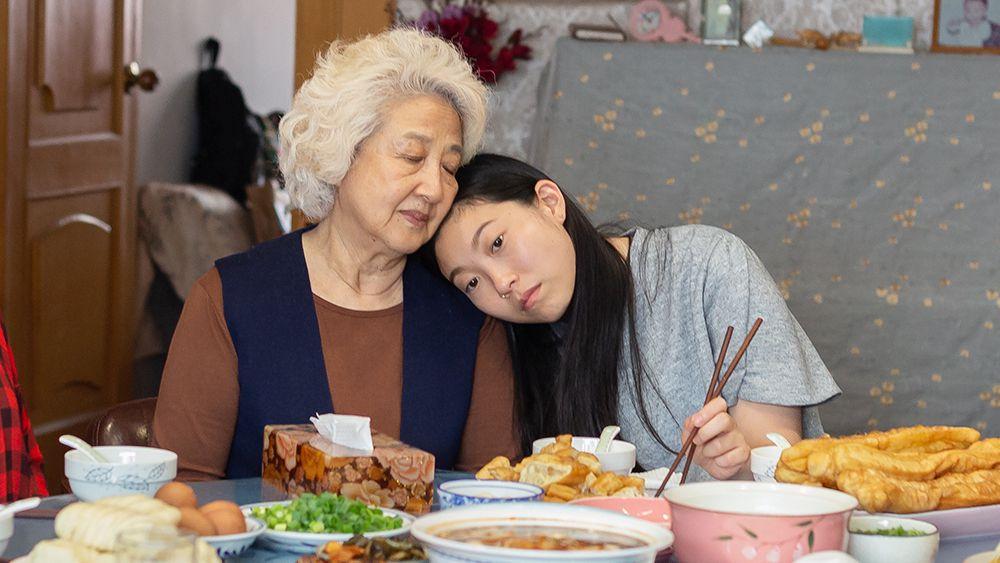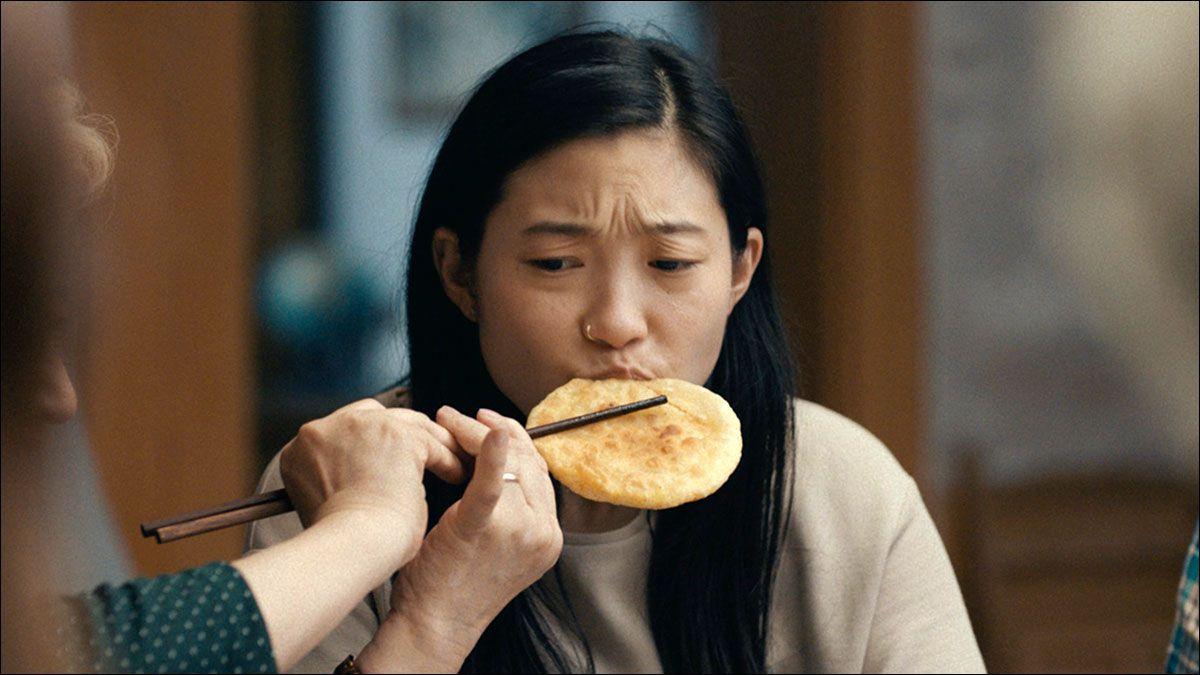There’s a scene in Lulu Wang’s second feature film, The Farewell, in which three generations of one Chinese family gather around a dining table. There are about a dozen such scenes in the movie, though this is one of the only ones that takes place outside the home. The family is eating dinner at a restaurant, seated around a circular table (always a circular table in China) while an uncannily self-rotating lazy Susan slowly circulates dishes around the table. The family has fully reunited for the first time in 25 years; they’ve gathered in their Chinese hometown to celebrate a grandson’s upcoming nuptials. Despite long-overdue catching up, the dialogue carefully tiptoes around an open secret: The grandmother—the matriarch of the family—has cancer, and they’ve decided not to tell her; the wedding is merely a pretense for everyone to say, per the film’s title, farewell. While the conversation often turns pained and stilted, it is the steady movement of the lazy Susan—reliably and even comedically in orbit—that reminds viewers of the unspoken tensions below the surface.
The sublimation of feelings into food is hardly a new theme. Nor is it a particularly Chinese theme. Take the Trip movies, for instance, in which Steve Coogan’s work as a British food critic of high-end restaurants is only a counterpoint to the mess that is his personal life. In the context of film history, the cultural ubiquity of food as an alternate means of communication has made it a convenient trope in cinematic expression. If movies are, indeed, as promised, a “universal language,” then food might be something like the syntax of emotional articulation. Think of some of the great food films: La Grande Bouffe, Babette’s Feast, Tampopo, Willy Wonka & the Chocolate Factory, Coffee and Cigarettes, Ratatouille—the list goes on, but you get the idea. Food in film functions as a visual shortcut to symbolizing metaphysical quandaries: problems of class, consumerism, tradition, hospitality, care, and desire; the kind of stuff that is hard to represent directly.
But even for films that don’t purportedly focus on food, scenes of eating often turn into the signature set piece of the movie. What would John Cassavetes’s A Woman Under the Influence be without the intense scene of marital warfare that is the breakfast spaghetti sequence? Or what about the sheer grotesqueness of eating a live octopus on display in Park Chan-Wook’s Oldboy? Some dining scenes are exemplary for their tenderness (Julie and Julia, Moonlight), while a similar setting might just as easily be rendered menacing (recall the genre of gangster films or literally any film by Quentin Tarantino). These moments stand out due to their surprising corporeality. Cinema may get its name for representing elusive celluloid dreams, but food nonetheless reminds us that those are real bodies on the screen. It’s no wonder that so many sex scenes involve some form of edible consumption. Food’s emphasis on bodily concerns—as well as the baser instincts that accompany it—means that it can easily turn from a mode of care to one of punishment.
If food so often functions as a way for characters to express themselves by other means, then The Farewell plays on a particular stereotype about food and Chinese inexpressibility. In framing overfeeding as a substitute for undersaying, it joins a host of other “Chinese American films,” such as The Joy Luck Club, Crazy Rich Asians, or any of Ang Lee’s earlier Taiwanese-American indie films. To be sure, there aren’t that many Chinese American movies to choose from, so the fact that the handful of them all repeatedly focus on scenes of eating—and, indeed, feeding—is worth examining.

The trope of Chinese repressiveness might be a few centuries old, but the act of eating is even older. And where feelings are hard to express through words, the constant—borderline aggressive—goad to keep eating becomes a tacit form of love. It’s a type of communication that doesn’t just cut across cultures, but generations as well. The famous opening scene of Ang Lee’s Eat Drink Man Woman, in which an aging father cooks an elaborate family dinner for himself and his three daughters, is perhaps the exemplary form of this expression in film.
It’s also the scene that epitomized Lee as a paramount director of food scenes, even though his two prior films—Pushing Hands and The Wedding Banquet—both spotlight the cultural politics of feeding and eating.
Lee’s first feature film, Pushing Hands, is especially remarkable for being one of the few films set in America that explicitly takes up the history of Chinese immigration and restaurant work. In the film, an aging Chinese martial arts teacher joins his son and grandson in New York, only to learn that there isn’t really a place for him in their new lives. As a last resort, the grandfather becomes a dishwasher at one of Chinatown’s busy restaurants—a job for which he is both overqualified and underskilled. Lacking the physical capacity for hard manual labor, he ultimately can’t wash the dishes fast enough, and he eventually gets fired. Yet, what becomes apparent over the course of his struggles is exactly the limited possibilities for a person like him in 1990s America—a limitation that is echoed in its Hollywood representation: Pushing Hands makes clear how China’s cultural investment in food isn’t simply representative of Chinese people, but is often the only way Chinese people get represented in American films, if at all.
For the longest time, you could only see an Asian person in a Hollywood movie if that Asian person was an extra working on the set of a Chinese restaurant. Think of the many classic westerns in which a colorful restaurant brawl often occurs inside an Orientalized establishment. In Hollywood films, Chinese restaurants are where people get proposed to (Mickey Blue Eyes), where deals get made (That Thing You Do!), where Midwestern white families celebrate Christmas (A Christmas Story). “Chinese takeout” basically constitutes its own subgenre: Woody Allen and Mariel Hemingway eating it in bed in Manhattan, Tom Cruise and wife celebrating his new job offer with it in The Firm, a divorced Robin Williams ordering it for his kids in Mrs. Doubtfire, Tom Hanks chowing down on it on Christmas Day in Catch Me If You Can. The association of Chinese food with comfort applies, perhaps above all, to Americans.
But whereas mainstream Hollywood cinema tells a covert history of Chinese labor through these set pieces, The Farewell inverts this by making these set pieces the central heart of its plot. Almost every emotionally significant scene in Wang’s film takes place around a stove, a chopping board, or a dining table. Early on in the film, Chinese American protagonist Billi (Awkwafina), who lives in New York City, drops by her parents’ one night for dinner. The scene stands in notable contrast to all the later dining scenes in China, taking place around a rectangle table and being shot from medium range. They’re drinking wine; they’re eating cake (two delicacies that you can probably forego when visiting China). What is meant to be conveyed in this discrepancy is some kind of cultural difference—the rectangle table’s sharp corners enforcing a formalized mode of conduct (Billi’s dad notably sits at the table’s head) as opposed to the more communal engagement that occurs when the family returns to visit Billi’s dying grandmother.
Yet, when Billi returns to China, expression doesn’t necessarily become any easier. While she disagrees with the family’s choice to keep the fatal diagnosis from her grandmother (known in the film only as “Nai Nai”—the Mandarin term for “grandmother”), tradition and seniority overrule her personal dissent. What results is a performance from Awkwafina that is consistently muted, depressive, and, crucially, unenthusiastic about food. At one point, Nai Nai urges Billi to take a big bite out of a homemade meat pancake, but all she can muster is a meek nibble. Taken together, these contrasting dining cultures convey how the difference between “American” versus “Chinese” rituals of dining is not that easy to disentangle. Billi is finally caught between a corner and a round place.

While the film largely takes place in China, its refraction through Billi’s point of view ultimately renders it an American film. Like the director herself, Billi emigrated from China at an early age, and her experience between cultures is both jarring and isolating. In what is perhaps the film’s most melodramatic performance, Awkwafina starts crying while explaining to her mother how scared and confused she was during those early years after moving to America. It’s also one of the film’s weakest scenes—a gesture of overexpression that grates against its other scenes of quiet ambivalence. The film’s working through of cultural conflict occurs most strikingly during scenes of nonverbal communication: between the stalled pauses of a dinner conversation; while Billi boils the otherwise undrinkable Chinese tap water; when Billi’s father, sloshed on baijiu, stumbles into bed.
While Wang’s film title purportedly refers to the family’s goodbye to Nai Nai, it also gestures to Billi’s farewell bid to an older way of Chinese life—a way of living that, as the film makes explicit at multiple points, is already disappearing through the backseat window. In this way, The Farewell feels like a direct inheritor of Ang Lee’s The Wedding Banquet, which also enables two Taiwanese parents to say goodbye to their Americanized son through the pretense of throwing him a lavish wedding party. And just like The Wedding Banquet, The Farewell is a film that is not merely about China or food. It’s not even, really, a film centrally about “the immigrant experience.” The clearest argument against such limited readings is the film’s food scenes, which lift it beyond a specific cultural stereotype and casually naturalize it as a mode of connection both universal and fraught. The Farewell’s focus on Chinese food makes it not a film about China, but instead, as Wang herself has put it, “an American film.”
Jane Hu is a writer and Ph.D. candidate living in Oakland.